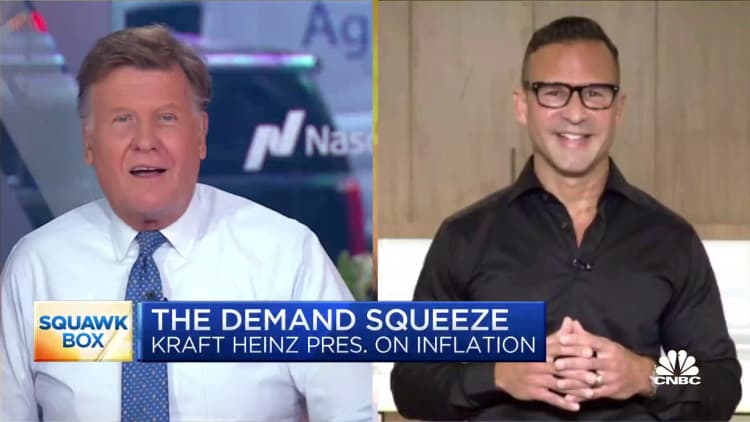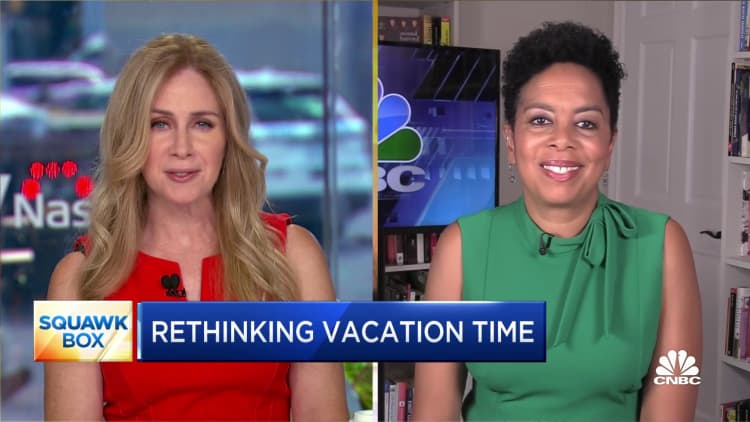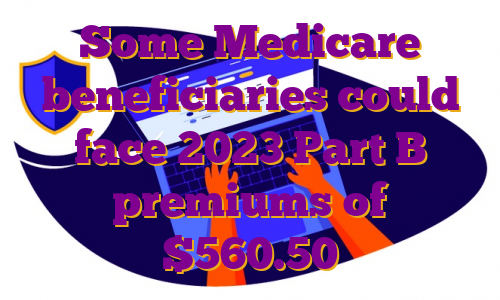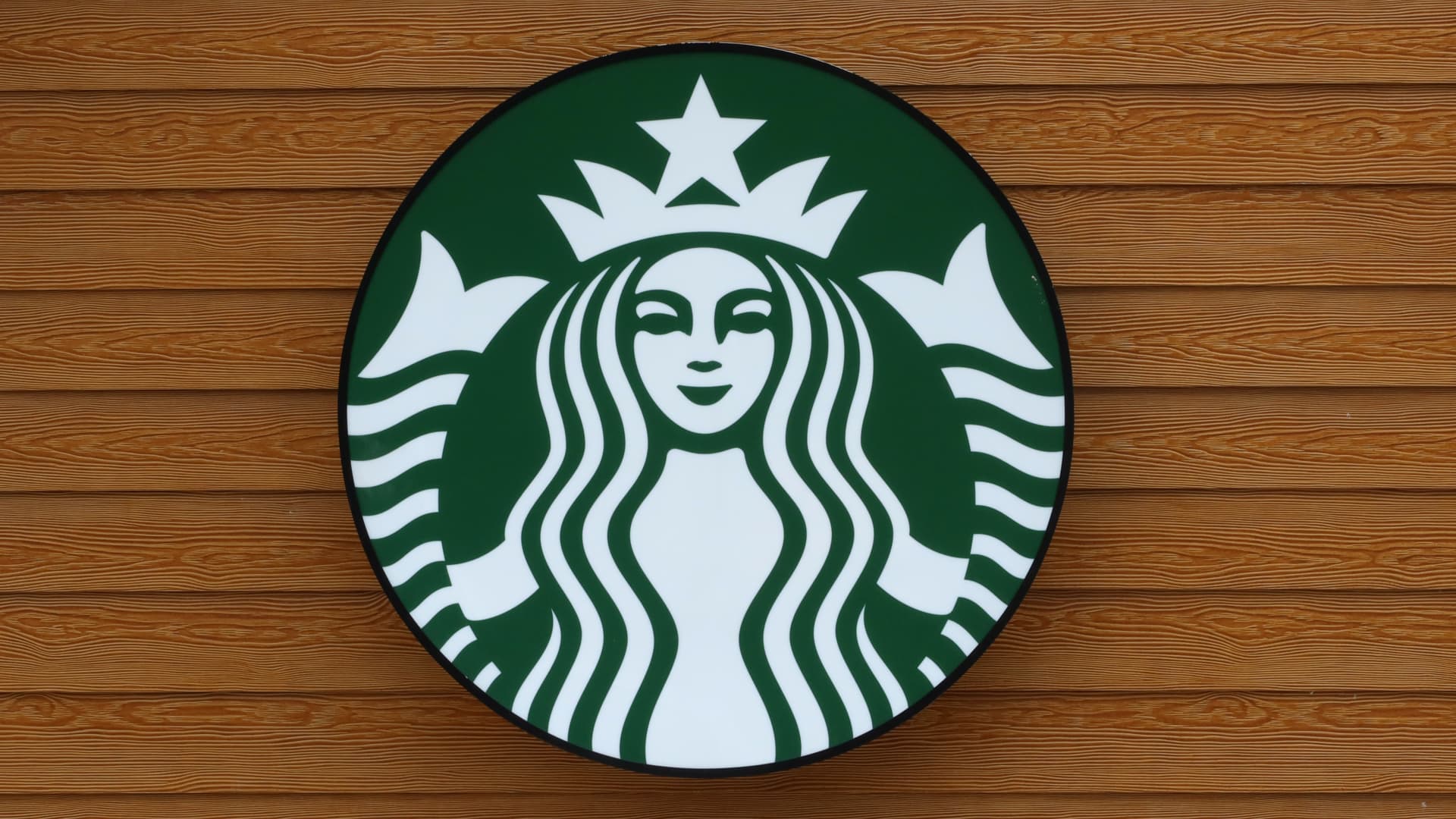Shapecharge | E+ | Getty ImagesIf you’re a higher-income Medicare beneficiary, you may be paying less in extra premium charges in 2023 than you were this year.So-called income-related adjustment amounts, or IRMAAs, which are based on your tax return from two years earlier, kick in next year at $97,000 for single tax filers and $194,000 for joint filers (based on their 2020 return), up from $91,000 and $182,000, respectively.Additionally, with the standard Part B (outpatient care coverage) premium dropping by 3% next year to $164.90 from $170.10 in 2022, the IRMAAs also are less costly.The surcharges apply to both Part B and Part D (prescription drug coverage) premiums and affect about 7% of Medicare’s 64.3 million beneficiaries. The higher your income, the higher the charge. (See charts below.)Whether you have to pay the surcharge is based on your modified adjusted gross income as defined by the Medicare program: your adjusted gross income plus tax-exempt interest income.”You only have to go $1 over that [lowest] breakpoint and you’re subject to IRMAAs,” said certified financial planner Barbara O’Neill, owner and CEO of Money Talk, a financial education company. “If you’re close to that or close to going to a higher tier, you’ve really got to be proactive,” O’Neill said.In other words, there are some strategies and planning techniques that can help you avoid or minimize those IRMAAs. Here are four to consider:1. Focus on income streams under your controlWhile some income in retirement is generally set — i.e., Social Security and/or a pension — the key to avoiding IRMAAs is to focus on what income streams you can control, said CFP Judson Meinhart, senior financial advisor and manager of financial planning for Parsec Financial in Winston-Salem, North Carolina.”The key to keeping [your income] below the IRMAA brackets is planning ahead to know where your income is coming from,” Meinhart said.More from FA Playbook:Here’s a look at other stories impacting the financial advisor business.Be aware that the IRMAA determination is typically based on your tax return from two years earlier. If your income has dropped since then, you can appeal the IRMAA decision using Form SSA-44 and providing proof that you’ve experienced a “life-changing event” such as retirement, death of a spouse or divorce.2. Consider Roth IRA conversionsOne way to keep your taxable income down is to avoid having all of your nest egg in retirement accounts whose distributions are taxed as ordinary income, such as a traditional IRA or 401(k) plan. So whether you’ve signed up for Medicare yet or not, it may be worth converting taxable assets to a Roth IRA.Roth contributions are taxed upfront, but qualified withdrawals are tax-free. This means that while you would pay taxes now on the amount converted, the Roth account would provide tax-free income down the road — as long as you are at least age 59½ and the account has been open for more than five years, or you meet an exclusion.”You pay a little more now to avoid higher tax brackets or IRMAA brackets later on,” Meinhart said.It also helps that Roth IRAs do not have required minimum distributions, or RMDs, in the owner’s lifetime. RMDs are amounts that must be withdrawn from traditional IRAs, as well as both traditional and Roth 401(k) accounts, once you reach age 72.When RMDs from traditional accounts kick in, your taxable income could be pushed up enough that you become subject to IRMAAs, or to a higher amount if you already were paying the surcharge.”A lot of people get into trouble by taking no money out of their 401(k) plan or IRA, and then they have their first RMD and it puts them in one of those IRMAA brackets,” Meinhart said.3. Keep an eye on capital gainsIf you have assets that could generate a taxable profit when sold — i.e., investments in a brokerage account — it may be worth evaluating how well you can manage those capital gains. While you may be able to time the sale of, say, an appreciated stock to control when and how you would be taxed, some mutual funds have a way of surprising investors at the end of the year with capital gains and dividends, both of which feed into the IRMAA calculation. “With mutual funds, you don’t have a whole lot of control because they have to pass the gains on to you,” said O’Neill, of Money Talk. “The problem is you don’t know how big those distributions are going to be until very late in the tax year.” Depending on the specifics of your situation, it may be worth considering holding exchange-traded funds instead of mutual funds in your brokerage account due to their tax efficiency, experts say.For investments whose sale you can time, it’s also important to remember the benefits of tax-loss harvesting as a way to minimize your taxable income.That is, if you end up selling assets at a loss, you can use those losses to offset or reduce any gains you realized. Generally speaking, if the losses exceed the profit, you can use up to $3,000 per year against your regular income and carry forward the unused amount to future tax years.4. Tap your philanthropic sideIf you’re at least age 70½, a qualified charitable contribution, or QCD, is another way to keep your taxable income down. The contribution goes directly from your IRA to a qualified charity and is excluded from your income.”It’s one of the few ways you can really get money out of an IRA completely tax-free,” Meinhart said. “And when you’re 72, that charitable distribution can help offset your required minimum distributions.”The maximum you can transfer is $100,000 annually; if you’re married, each spouse can transfer $100,000. .
Depending on the specifics of your situation, it may be worth considering holding exchange-traded funds instead of mutual funds in your brokerage account due to their tax efficiency, experts say.For investments whose sale you can time, it’s also important to remember the benefits of tax-loss harvesting as a way to minimize your taxable income.That is, if you end up selling assets at a loss, you can use those losses to offset or reduce any gains you realized. Generally speaking, if the losses exceed the profit, you can use up to $3,000 per year against your regular income and carry forward the unused amount to future tax years.4. Tap your philanthropic sideIf you’re at least age 70½, a qualified charitable contribution, or QCD, is another way to keep your taxable income down. The contribution goes directly from your IRA to a qualified charity and is excluded from your income.”It’s one of the few ways you can really get money out of an IRA completely tax-free,” Meinhart said. “And when you’re 72, that charitable distribution can help offset your required minimum distributions.”The maximum you can transfer is $100,000 annually; if you’re married, each spouse can transfer $100,000. .
Starboard snaps up a position in Wix, and building free cash flow may become a focal point
Marco Vdm | E+ | Getty ImagesCompany: Wix.com (WIX)Business: Wix.com is an Israeli information technology company that develops and markets a cloud-based platform that enables users to create a website or web application. Their platform consists of three web creation products, each with a different purpose or primary audience: (i) Wix ADI, intended for fast website creation; (ii) the Wix Editor, intended for full website creation targeted at users with basic, average or above average technological skills; and (iii) Editor X, intended for advanced users such as design professionals. As of Dec. 31, 2021, Wix had approximately 222 million registered users and 6 million premium subscriptions.Stock Market Value: $4.2B ($72.21 per share)related investing news
Analysts name the top ‘high conviction’ stocks for playing the market turbulenceActivist: Starboard ValuePercentage Ownership: 9.00%Average Cost: $66.79Activist Commentary: Starboard is a very successful activist investor and has extensive experience helping companies focus on operational efficiency and margin improvement. Starboard also has a successful track record in the information technology sector. In 45 prior engagements, it has a return of 32.36% versus 13.90% for the S&P 500 over the same period. Starboard has had a notable track record with web applications companies going back to 2004 with their 13D investment in Register.com. Register.com was sold to Web.com in 2005 for $135 million, yielding Starboard a 30.82% return versus 11.37% for the S&P 500 over the same period. On June 8, 2018, Starboard filed a 13D on Web.com Group Inc. In October 2018, Web.com was acquired by Siris Capital Group and combined three years later with Endurance International, a comp to GoDaddy’s hosting business. Starboard made a 47.27% return on its Web.com 13D versus a decline of 1.82% for the S&P 500 over the same period. Finally, on Dec. 27, 2021, Starboard filed a 13D on GoDaddy Inc. which is a live 13D where Starboard currently has a 6.12% return versus 19.16% decline for the S&P 500 over the same period.What’s Happening?Behind the ScenesWix is a market leader in web development tools that operates in an attractive space with long-term growth tailwinds. They have a sticky business that is not typically affected in bad economies: People do not shut down their websites in down markets.Prior to Covid, the company was growing in the high teens but growth increased to approximately 30% per year during the pandemic. During this time, Wix increased its cost structure and hired new employees. However, this high rate was not a new, perpetual level of growth as much as it was an accelerant, and since Covid the company’s growth rate has declined to approximately 10%. As a result, Wix’s free cash flow margins declined from 15% to 0%. These margins should not only return to 15% but could exceed 20%.Wix initially targeted 20% FCF margins but that assumed a 20% growth rate. They have since committed to 20% FCF margins by 2025 that is not dependent on 20% growth by implementing a $150 million cost savings program. If the company is committing to 20%, it is very likely that more than that can be done and we have seen companies significantly exceed their estimates before with Starboard involved. As they have done many times in the past, Starboard will work with Wix to help generate a better balance of growth and profitability. While the Rule of 40 (growth rate plus profit margin) for software companies does not squarely apply here, it is certainly analogous and Starboard could work with the company to help it achieve double-digit growth rates and double-digit free cash flow margins.In addition to the cost savings plan, Wix had announced a plan to buy back $500 million of stock. Sounds like things companies do when they know there is an activist at the door. Whatever the motivation, it is good for shareholders that it appears that the company and Starboard are on the same page, and it looks like they can work together to increase shareholder value. Starboard has extensive experience in helping companies optimize growth and margins, typically from a board level. Based on their history and track record, we think this would be best done with Starboard getting one or two seats on the board.While Starboard’s primary objective here is operational, when an activist engages with a company, it often puts that company in pseudo-play getting the attention of strategic investors and private equity. While Starboard is not advocating for any strategic transaction, they are economic animals with fiduciary duties. If an offer came in at the right price, they would weigh it against shareholder value as a standalone entity and do what they believe to be best for shareholders. There has also been speculation that Starboard is trying to get Wix acquired by GoDaddy, as Starboard is one of the largest shareholders of GoDaddy. GoDaddy is not likely the best potential acquirer for this Company and this is not something Starboard would even suggest. If GoDaddy or anyone else showed an interest in acquiring the Company and the Company decided to sell, Starboard would recommend that the Company sell to the best offer after an arms-length sales process.There is one other similarity between Wix and many other Starboard activist positions. It is run by the founder, who often is not the best person to operate a public company. Moreover, in this case, the company’s co-founder, CEO and director Avishai Abrahami; co-founder and VP of client development Nadav Abrahami; and chief architect of research and development Yoav Abrahami, are all brothers. Also, the president and COO, Nir Zohar, is married to the VP Design & Brand, Hagit Zohar. While this could look like a classic case of nepotism and a founder-led company being run like a private firm, this is not necessarily the case here and not likely a focus of Starboard. This management team developed great products resulting in a best-of-breed market leader. Moreover, they are already taking steps to focus on operations. This is not about selling Wix or replacing management, but purely working with the company to focus on free cash flow and shareholder value as opposed to solely focusing on growth.Ken Squire is the founder and president of 13D Monitor, an institutional research service on shareholder activism, and he is the founder and portfolio manager of the 13D Activist Fund, a mutual fund that invests in a portfolio of activist 13D investments. Squire is also the creator of the AESG™ investment category, an activist investment style focused on improving ESG practices of portfolio companies. .
Premium products take priority as companies battle cost-of-living
“As we create more premium beverages, it becomes more difficult for customers to replicate it at home and we think that helps with the concept of trade down,” Starbucks CFO Rachel Ruggeri told CNBC’s “Squawk Box” on Aug. 3.Gary Hershorn / Contributor / Getty ImagesPersonalized coffees, “prestige” skincare and “elevated” sauces and spreads are just some examples of how companies like Starbucks, Unilever and Kraft Heinz are tilting their focus toward premium products — and consumers appear to be loving it.But why are companies zooming in on their pricier offerings when consumers are feeling the effects of the biggest inflation shock in decades?related investing news
What to expect when Costco reports earnings after the closing bell Thursday”Customer insight is key for consumer businesses as the cost of living squeeze tightens,” Paul Martin, KPMG’s U.K. Head of Retail, told CNBC.”Whilst it’s true that some consumers are having to increasingly turn to value products and watch every penny, it is also the case that other consumers are nervous about the economic outlook but still have money to spend and are in essence trading down to premium products,” Martin said.”For example, swapping meals out for premium meals in. Whilst this group will also look to save money via the value essentials, they won’t be filling the basket solely with them,” he said.’An offering that’s worth paying for’Starbucks reported record customer counts and sales in the last quarter, beating Wall Street expectations. The results appear to reaffirm the view that some customers aren’t trading down or reducing their spending despite the increasing cost of living.Designing bespoke products is key to upping customer engagement even when money is tight, Starbucks CFO Rachel Ruggeri told CNBC’s “Squawk Box” on Aug. 3.”As we create more premium beverages, that’s more difficult for customers to replicate at home and we think that helps with the concept of trade down,” Ruggeri said. “It may mean that maybe a customer doesn’t come as frequently, but we want to ensure that we have reasons for the customers to come into the stores and interact with us.”Giving customers more flexibility also helped to sell more expensive products and pass on higher costs, Ruggeri said. “We’ve been able to do that through our personalization, which is a choice, and what we’ve seen so far is our demand is strong. And that tells us that we have an offering that’s worth paying for,” she said.The focus on premium products isn’t unique to the largest coffee chain in the U.S.Kraft Heinz is getting in on the luxury market with the launch of its HEINZ 57 Collection in July. The “chef-inspired” condiments are “designed to add magic to the culinary experience,” according to the company.This came as the company lifted prices by more than 12% in response to higher transportation, labor and ingredients costs amid rising inflation.
 The introduction of more premium products is in addition to redesigns of classic products, according to the company’s U.S. president Carlos Abrams-Rivera.”One focus is how do we optimize formulas to bring in ingredients that are cheaper,” Abrams-Rivera told CNBC’s “Squawk Box” on July 28. “And how do we customize our products to the different consumers so they can access different products at different price points.”Treading a similar path is Mondelez. The company announced in June a deal to acquire organic-focused Clif Bar & Company, while all the company’s 2021 acquisitions — Hu Master Holdings, Lion/Gemstone Topco and Gourmet Food Holdings — were described as “premium” in its second-quarter earnings report.’Value faces a boom and so does premium’Unsurprisingly, consumers are also reliant on cheaper products, which companies are also sensitive to.McDonald’s, for example, attributed some of its growth in the U.S. to its value products in its Q2 2022 earnings report.Other companies are looking to attract both ends of the market by focusing on higher and lower-priced products.Nestle CEO Mark Schneider told investors in the company’s half-year results earnings call that the approach has been used before.”What we’re seeing with the current situation is similar to what happened in previous economic slowdowns and downturns,” Schneider said. “We pay attention to premium products but we also pay attention to affordable products. By covering both ends of this spectrum we’re doing well and we’re serving those needs.”Appealing to the widest possible customer base is key to maintaining and growing profits in the current economic climate, according to KPMG’s Martin.”In this landscape, value faces a boom and so does premium. Supermarkets recognize it, including the discounters, who are expanding their core value ranges, but also beefing up their premium proposition. Their aim is to capture and retain all of the trade-down audiences,” Martin said.Driving desirability and salesUnilever CEO Alan Jope told CNBC’s “Squawk Box” that the company was seeing a mixture of customers trading up and trading down.”The premium ranges in our portfolio are actually doing very well … We are seeing some downtrading – that’s on pack size, where people are moving to more affordable formats,” he said on July 26.In 2014, Unilever launched Prestige, a luxury arm of the conglomerate that now includes Dermalogica, Tatcha and Paula’s Choice.Described as “a string of pearls” by Executive VP and Group CEO Vasiliki Petrou in December, the model relies on “a certain level of scarcity” to drive desirability and sales.So far, it appears to have worked. Beauty & Personal Care grew 7.5% in the last quarter, driven by “strong growth” in Prestige Beauty and Health & Wellbeing, according to the company’s Q2 2022 results announcement.A focus on premium products can also be a more palatable means of tackling inflation costs compared to reducing items or packaging sizes, according to EY global consumer leader Kristina Rogers.”There is a limit to these actions and considering that input costs continue to rise, companies are looking at how to expand the value of their products,” Rogers told CNBC.”The only way to grow is therefore to go the premium and added value route. Companies need to demonstrate the added value of their brands and give consumers a good reason to buy higher-priced products,” Rogers said.”Companies are focusing on increasing the features of their product to extend consumers’ willingness to pay. These features include brand building, higher quality products, sustainability, or health features, to help validate a higher premium to be charged,” she added. .
The introduction of more premium products is in addition to redesigns of classic products, according to the company’s U.S. president Carlos Abrams-Rivera.”One focus is how do we optimize formulas to bring in ingredients that are cheaper,” Abrams-Rivera told CNBC’s “Squawk Box” on July 28. “And how do we customize our products to the different consumers so they can access different products at different price points.”Treading a similar path is Mondelez. The company announced in June a deal to acquire organic-focused Clif Bar & Company, while all the company’s 2021 acquisitions — Hu Master Holdings, Lion/Gemstone Topco and Gourmet Food Holdings — were described as “premium” in its second-quarter earnings report.’Value faces a boom and so does premium’Unsurprisingly, consumers are also reliant on cheaper products, which companies are also sensitive to.McDonald’s, for example, attributed some of its growth in the U.S. to its value products in its Q2 2022 earnings report.Other companies are looking to attract both ends of the market by focusing on higher and lower-priced products.Nestle CEO Mark Schneider told investors in the company’s half-year results earnings call that the approach has been used before.”What we’re seeing with the current situation is similar to what happened in previous economic slowdowns and downturns,” Schneider said. “We pay attention to premium products but we also pay attention to affordable products. By covering both ends of this spectrum we’re doing well and we’re serving those needs.”Appealing to the widest possible customer base is key to maintaining and growing profits in the current economic climate, according to KPMG’s Martin.”In this landscape, value faces a boom and so does premium. Supermarkets recognize it, including the discounters, who are expanding their core value ranges, but also beefing up their premium proposition. Their aim is to capture and retain all of the trade-down audiences,” Martin said.Driving desirability and salesUnilever CEO Alan Jope told CNBC’s “Squawk Box” that the company was seeing a mixture of customers trading up and trading down.”The premium ranges in our portfolio are actually doing very well … We are seeing some downtrading – that’s on pack size, where people are moving to more affordable formats,” he said on July 26.In 2014, Unilever launched Prestige, a luxury arm of the conglomerate that now includes Dermalogica, Tatcha and Paula’s Choice.Described as “a string of pearls” by Executive VP and Group CEO Vasiliki Petrou in December, the model relies on “a certain level of scarcity” to drive desirability and sales.So far, it appears to have worked. Beauty & Personal Care grew 7.5% in the last quarter, driven by “strong growth” in Prestige Beauty and Health & Wellbeing, according to the company’s Q2 2022 results announcement.A focus on premium products can also be a more palatable means of tackling inflation costs compared to reducing items or packaging sizes, according to EY global consumer leader Kristina Rogers.”There is a limit to these actions and considering that input costs continue to rise, companies are looking at how to expand the value of their products,” Rogers told CNBC.”The only way to grow is therefore to go the premium and added value route. Companies need to demonstrate the added value of their brands and give consumers a good reason to buy higher-priced products,” Rogers said.”Companies are focusing on increasing the features of their product to extend consumers’ willingness to pay. These features include brand building, higher quality products, sustainability, or health features, to help validate a higher premium to be charged,” she added. .
‘Avatar’ returns to theaters as Disney hypes James Cameron’s long-delayed sequel
AvatarSource: Walt Disney StudiosThe Na’vi return to the big screen this weekend as Disney looks to reignite interest in its newly acquired Avatar franchise, three months before the debut of the long-delayed sequel, “Avatar: The Way of Water.”Bringing the highest-grossing film of all time back to theaters has two purposes for Disney: drum up excitement for “The Way of Water” and fill a vacant spot on the theatrical calendar. The sequel is one of four due over the next decade.The rerelease of the original film is a sort of litmus test for whether audiences still want to visit its eco-conscious science fiction world.”Many questions have been asked about the film’s pop culture legacy over the past decade, but we also have to remember that James Cameron has been doubted before and proven many wrong,” said Shawn Robbins, chief analyst at BoxOffice.com.Directed by Cameron, the mastermind behind “Titanic” and “The Terminator,” “Avatar” opened in late 2009 to wide acclaim and massive financial success, eventually earning nine Oscar nominations. But it never captured the cultural relevance that Star Wars or the Marvel Cinematic Universe – both also owned by Disney – have enjoyed. Toy sales fizzled and cosplayers donning heavy blue makeup at pop culture fan conventions have become few and far between.”Naturally all eyes will be on the box office performance this weekend, as this may serve as an indicator of audience interest in the December release of ‘The Way of Water,'” said Paul Dergarabedian, senior media analyst at Comscore.”Avatar” captivated audiences more than a decade ago, in part because of the technology that Cameron helped develop to film and animate the movie. The film was shot using the Fusion Camera System, which was created by Cameron and cinematographer Vince Pace. Academy Award-nominated films like Martin Scorsese’s “Hugo” and Ang Lee’s “Life of Pi” also utilized this camera system.Previous systems used two cameras because filmmakers had determined that the human brain processed different information from different sides of the brain. So, one part of the brain would process the image’s movement, while the other would process what was happening in the image.Set more than a decade after the events of the first film, “Avatar: The Way of Water” tells the story of the Sully family.DisneyCameron and Pace devised a camera that could capture images the same way that a human eye does. The results were breathtaking — just look at the ticket sales. During its initial run, “Avatar” snared $2.78 billion globally. It added additional ticket sales throughout the years through rereleases, and reclaimed the box-office crown from “Avengers: Endgame” in 2021 when it was redistributed in China, topping $2.84 billion.The majority of tickets sold for the film were for 3D showings, which tend to be more expensive than regular tickets. These premium tickets alongside, an extended nine-month run in theaters, helped bolster “Avatar’s” total box-office haul.”We know that IMAX and other [premium format] screens are a major driver for the business now and going forward, but 3D’s popularity in North America waned quickly in the years after the first ‘Avatar’s’ original release,” Robbins said. “With very rare exceptions, 3D simply began to turn off many moviegoers for a variety of reasons — some of which filmmakers can control, but not all.”This “3D gold rush” in the wake of “Avatar,” as Dergarabedian calls it, led to an oversaturation of the market. Many of the 3D releases were conversions of movies that were not well suited for the format and, thus, quality declined and so did interest from audiences.While 3D films have fallen out of favor with domestic audiences, they remain exceptionally popular internationally – especially in China. Indeed, “Avatar” made the bulk of its money outside of the U.S. — a whopping $2.08 billion.”If I’m reading between the lines for this distribution plan, it seems like Disney and 20th Century Studios are gauging the state of 3D’s branding and they may use the box-office results to inform how ‘The Way of Water’ is handled,” Robbins said. “While Cameron will want to push the 3D version for fans who want to see it the way he filmed it for, it’s also hard to ignore the very large audience out there who has never become as enamored with the format as they have with other 2D premium viewing options.”Current estimates for the film’s rerelease range from $7 million to $12 million, with box-office analysts saying a figure in the mid-teens would be “huge.” It’s also facing stiff competition from the historical action epic “The Woman King,” which had a strong opening this past weekend and could be primed for a long, successful run at the box office.”It would be a massive understatement to say that there is a lot riding on the ‘Avatar’ brand and with at least three more filmed installments on the way,” Dergarabedian said. “The rerelease of the original this weekend will be the linchpin for what the future holds for the universe of Pandora and beyond.” .
Open enrollment season for 2023 employee benefits is getting underway
Hinterhaus Productions | Digitalvision | Getty ImagesIt’s that time of year, when workers get to make some decisions about their employee benefits.Many companies are beginning to hold their annual open enrollment period, which is when employees can sign up for 2023 health insurance — as well as consider other benefits, if your employer offers them. Some may offer extras like supplemental life or disability insurance, pet insurance or help with education costs.”People tend to [review] their benefits very quickly,” said Paul Fronstin, director of health benefits research at the Employee Benefit Research Institute. “I think the most important thing is that you actually look at what’s being offered.”More from Personal Finance:
How to save as food inflation jumps more than 11% in a year
Here’s how much you can save by secondhand shopping
Pay isn’t keeping up with inflation. What experts say to doFor health insurance, workers may have options to choose from, including a high-deductible health plan, which in 2023 means one with a deductible of at least $1,500 for single coverage and $3,000 for a family plan.Because of the higher deductible — the amount you pay for covered medical costs before insurance kicks in — the monthly premiums may be lower than other coverage options.Health savings accounts come with triple tax benefitHigh-deductible plans also might come with a health savings account, or HSA. This comes with a triple tax benefit: Contributions are made pretax, investment growth is untaxed and withdrawals spent on qualified medical expenses are tax-free also. For 2023, the annual cap on HSA contributions is $3,850 for self-only coverage and $7,750 for family coverage. You also can leave the money there from year to year.If no HSA is offered, your company might offer a health flexible spending account, or FSA. Money you contribute to FSAs are also made pretax and used to cover medical expenses. This year, the contribution limit is $2,850 per employee. (FSA caps for 2023 have not been announced yet.)You could end up losing at least part of [your contributions], depending on how the FSA is set up.Paul FronstinDirector of health benefits research at the Employee Benefit Research InstituteHowever, they usually come with a “use it or lose it” clause — meaning if you don’t spend the balance by the end of the year, you lose it unless your company is among those that give you a grace period or allow a certain amount to roll over to the next year.”You have to think carefully about how often you go to the doctor, how much are your maintenance medications,” Fronstin said. “You could end up losing at least part of [your contributions], depending on how the FSA is set up.”Regardless of whether you use either of those pretax savings options, it’s important to consider how you’d cover any out-of-pocket costs that arise from seeing a doctor or otherwise using the health care system, said Jeff Levin-Scherz, a managing director for Willis Towers Watson. “It can cost more in premiums to pay less out of pocket … but many families can’t afford unexpected costs,” Levin-Scherz said. Employees are contributing an average $4,412 for their health insurance in 2022, of which $2,520 is paid in the form of premiums and $1,892 is paid through cost sharing such as deductibles, copays and coinsurance, according to Aon.Other benefits may be availableAside from health insurance, you may be offered disability insurance for free or at a low cost. The two basic types are short-term disability, which generally replaces 60% to 70% of your salary, and long-term disability, which generally kicks in after three to six months and is about 40% to 60% of your income. Some companies also let you purchase additional coverage. The same goes for life insurance: You may get a certain amount of coverage — say, equal to one year’s salary — for a low or no premium, with the opportunity to purchase additional coverage.If you consider purchasing extra disability or life insurance, keep in mind that the policy is generally tied to your employment at the company offering the coverage — meaning if the coverage is important to you for the long term, you may want to explore securing a policy outside of the workplace.Other common benefits that might be available through your job include financial planning, tuition reimbursement programs and backup child care, according to a 2021 survey from Willis Towers Watson. Some companies also are offering emergency savings options, providing help with student loan debt or making contributions to 529 college savings plans. .
“It can cost more in premiums to pay less out of pocket … but many families can’t afford unexpected costs,” Levin-Scherz said. Employees are contributing an average $4,412 for their health insurance in 2022, of which $2,520 is paid in the form of premiums and $1,892 is paid through cost sharing such as deductibles, copays and coinsurance, according to Aon.Other benefits may be availableAside from health insurance, you may be offered disability insurance for free or at a low cost. The two basic types are short-term disability, which generally replaces 60% to 70% of your salary, and long-term disability, which generally kicks in after three to six months and is about 40% to 60% of your income. Some companies also let you purchase additional coverage. The same goes for life insurance: You may get a certain amount of coverage — say, equal to one year’s salary — for a low or no premium, with the opportunity to purchase additional coverage.If you consider purchasing extra disability or life insurance, keep in mind that the policy is generally tied to your employment at the company offering the coverage — meaning if the coverage is important to you for the long term, you may want to explore securing a policy outside of the workplace.Other common benefits that might be available through your job include financial planning, tuition reimbursement programs and backup child care, according to a 2021 survey from Willis Towers Watson. Some companies also are offering emergency savings options, providing help with student loan debt or making contributions to 529 college savings plans. .








